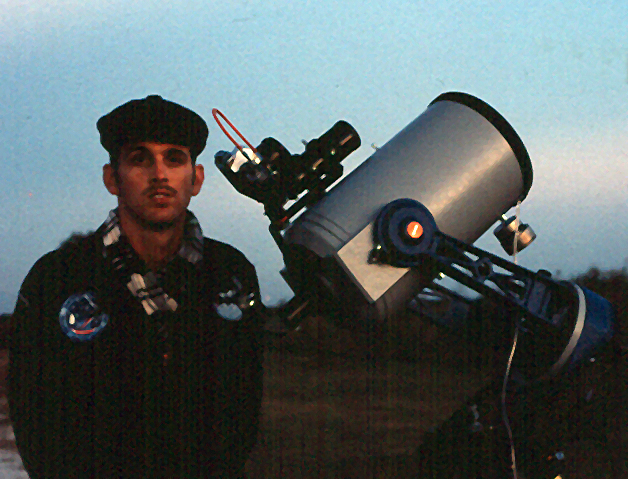
Equipment
Over they years, I have acquired all sorts of equipment and telescopes. Some of it was very good and some of it was pretty bad. This gallery and discussion below may help you make a decision when acquiring astronomical equipment of your own.
My first telescopes were all small refractors. The first scope that delivered reasonable images was a Focal 40mm refractor I got for my birthday. It was a table top tripod and delivered an amazing 50X. However, I did manage to get started with this instrument. I learned the lunar features, saw the moons of Jupiter dance about the planet, was dazzled by Saturns rings, and I also managed to see a few open clusters in my Messier catalogue with the instrument. Over the next few years, I managed to move upward in my telescopes. I had a 2-inch refractor that performed just a bit better than the table top scope and a year or two later finally got a quality second hand 3-inch refractor made by Edmund telescopes. I was able to observe almost the entire Messier catalogue with the 3-inch. Unfortunately, it began to fail on me. The big equatorial head rusted and broke. Then the focusing tube rack broke on me. As a result, I had to focus by pulling the tube in and out by hand. I used the old two-inch scope mount to create a working mount and the scope performed well until I joined the navy.
After I joined the Navy, I realized I needed something portable as I seemed to move from place to place as I went through my early training. After several months, I decided on a fancy new telescope that seemed ideal for my needs. I bought the "big red ball" - the Astroscan 2001. The 4-1/4" reflecting telescope was a nice little scope and it served me well for about four years. I even learned to take afocal images through this telescope. My prize photographs were of a Venus occultation in December 1978.
By the early 1980s, my career in the Navy settled down and I wanted something with a bit more punch in magnification and light gatherings. With part of my reenlistment bonus I decided to purchase an 8-inch SCT. The Celstron 8-inch SCT was the apple of my eye but it was beyond my financial means. Instead, I settled on the Dynamax 8, which was a poor mans Celestron in the early 1980s. With this telescope I began to learn how to perform piggyback photograph. This image shows me with the Dynamax and a 35mm being piggybacked. Note the interesting counterweight arrangement I created at the end of the scope.

The problem with the Dynamax 8 was that it's drive was not the best and it required a special inverter to control the RA. There was also no declination control. By late 1987, I felt a need to move on to the next stage. I wanted a big and better SCT that had the RA and Dec controls. The Meade 10-inch LX-3, which was being replaced by the LX-5 was on sale at the time, was the next obvious step. This image shows me with the LX-3 in 1995. Notice the Lumicon giant easy guider mounted on the back of the scope.
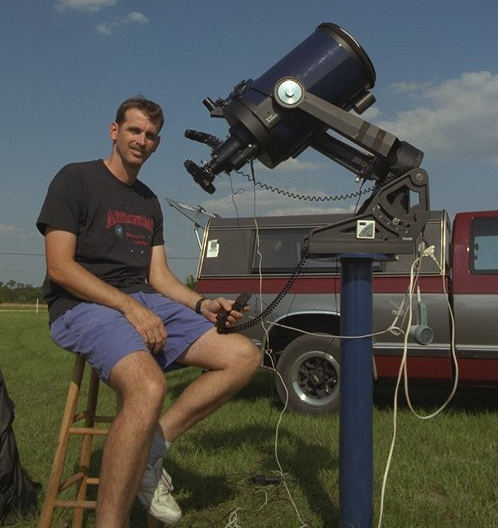
I would also add an 80mm F5 refractor assembled from a University Optics kit. I wanted this so I could use it in my travels with the Navy in 1989. It was the critical instrument for my trip to Baja in 1991, where I saw the total solar eclipse. Here it is piggybacked on the LX-3 SCT.
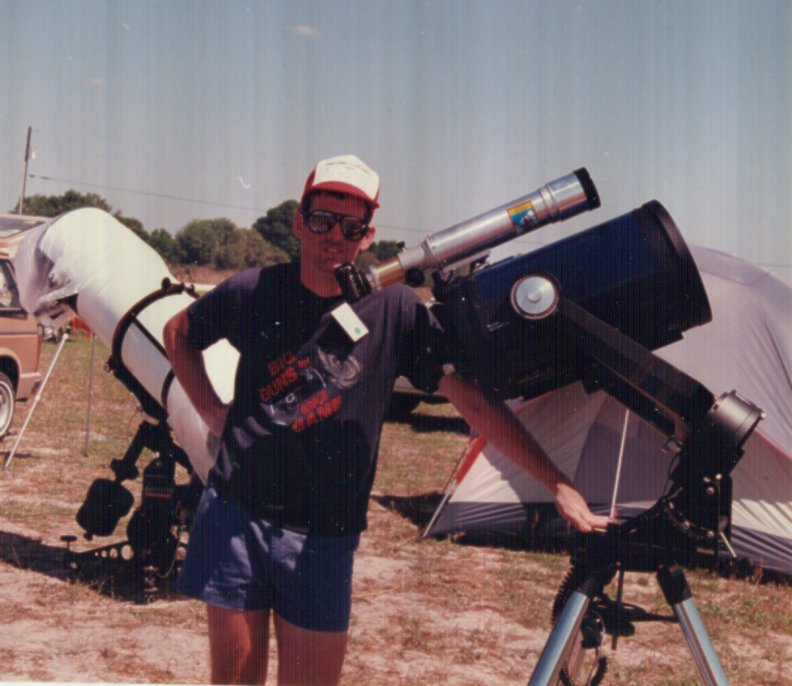
I also obtained a Takahashi sky patrol camera system for my travels. I would add a bausch and lomb 800mm spotting scope for a guide scope. This worked well for many years but the drive motor failed around 1994 and Takahashi stopped their support for such an instrument, so this fine mount ended up in the scrap draw still awaiting a drive motor that can be employed to make it work properly. This photograph shows the arrangement I used for some astrophotographs. Note the Bausch and Lomb guidescope and 80mm refractor.
![]()
The 10-inch LX-3 served me well for many years until 1996, when the motor failed during Comet Hyakutake. It took great effort to get somebody to repair the motor because Meade no longer supported the LX-3. Therefore, I decided to upgrade to a 10-inch LX50 SCT, which was inexpensive as well as capable of using an autoguider, which I also purchased. The LX50 was a nice scope except the drive was not as good as I expected. Unless the scope was well balanced, it tended to slip or speed up. Still, it was not that bad a scope for most uses and I imaged quite a bit with it. I still have the LX50 and use it in my observatory for moon and planets. This is me with the telescope setup for astrophotography. The Lumicon easy guider is still mounted on the scope. I have a Pentax camera with a 200mm F2.8 lens underneath the front acting as a counterweight. On the top is a mounting bracket that was made by my buddy Andy Druga so I could mount my Nikon camera with a 400mm F5.6 lens.
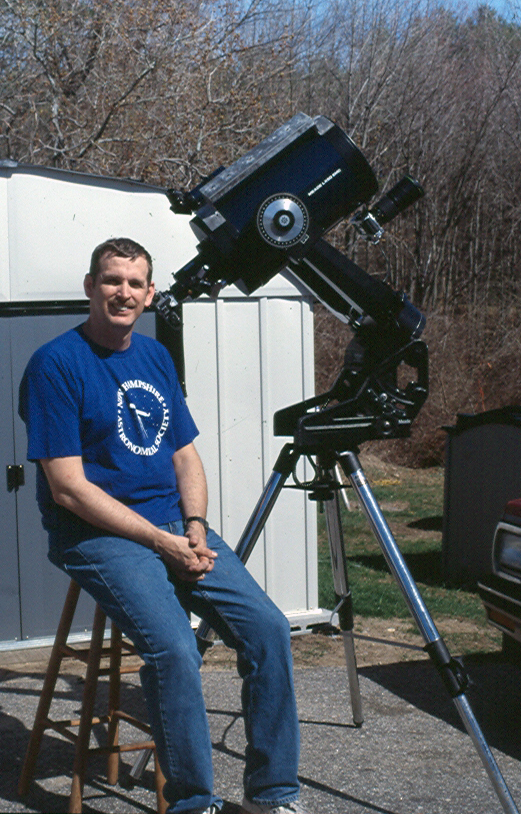
I attempted in 1997 to build my own telescope for use in Hawaii while I was stationed there. It was a failure of a scope because the Orion EQ mount I was using was not adequate to support the scope. It was nice for looking at the moon but it had many flaws that just prevented me from really using it in the way I desired. Since that time, I disassembled it for the key components. I only have the mirror (which is badly stained from storage), its cell and the secondary. I also have the inexpensive low profile focuser. Several of these would come in handy later.
My wife recognized my telescope fever and would by me a Newtonian 8-inch telescope for Christmas in 2000. Unfortunately, I made a mistake and pointed her towards a Discovery telescope line which had a less than satisfactory mount system. I would attempt to modify the reflector for astrophotography by removing the focuser and the secondary and replacing them with the items from my 6-inch reflector attempt. This improved the instrument somewhat and I was able to use it for some astrophotography even with the less than satisifactory equatorial mount by employing the Bausch and Lomb spotting scope I had obtained years before. This photograph shows my wife and I with the scope while camping.
In an effort to improve the scope, I had my wife purchase me a 90mm guidescope from University optics. The results of adding this was less than satisfactory as the mount failed to handle anything other than the weight of the scope. As a result, the 8-inch reflector sat in a corner for several years as I kept trying to make the LX50 serve my needs when I went to the dark sky site. As I have grown older, the LX50's weight began to become a concern of mine. On several occassions I decided not to go out and do astronomy because of a slight pain in my back, I feared lifting the LX50 onto the mount would hurt me seriously. The last thing I desired was to hurt my back in an out of the way place with nobody there to help me get home! This photograph shows the 90mm being used as a guide scope for the LX-50.
My next effort was to add a refractor to the mix. My wife again purchased me a portable refractor for Christmas that I wanted to use as a piggyback lens with my camera or as a portable instrument using the mount I had from the Discovery 8-inch. This was an Orion 120mm F5 achromat that worked very well but not so hot as an astrophotography platform. Even when using a minus violet filter, it still had some blue halos in my photographs. It was great for short exposures but I began to realize that getting inexpensive items was not going to work for me. I had to get something with more bang for the buck. This photograph shows the refractor being piggybacked on the LX-50.
In 2008, I took my "Economic stimulus" check and bought a Meade LX-75 mount. On this, I mounted the old 8-inch Discovery telescope. Finally, I had an instrument that could be used for photography and a mount that could handle the reflector and a guidescope. This was the ideal instrument to take out to the dark sky site and required no heavy lifting. The 8-inch was a good scope and served me fairly well but I felt an urge to get something with a better design. This photograph shows the 8-inch and the 90mm guidescope mounted on the LX-75 mount.
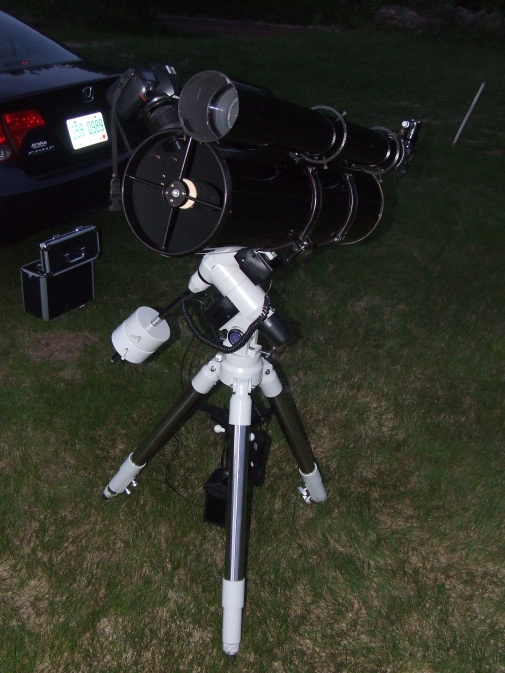
As a result, I once again purchased a new scope. Orion was selling a 6-inch imaging reflector that I had to have. So at Christmas, my wife bought me my most recent telescope. Coupled with the LX-75 mount and 90mm guidescope it appears to be an excellent purchase. I finally had an instrument with the focal length and F-ratio I desired (750mm F5) that would make photographs of most deep sky objects a joy. If I want to shoot longer focal length images, I can always use the 8-inch (1000mm F5) or my Meade LX50 10-inch SCT. This photograph shows the 6" Orion imaging scope on the LX-75 mount.
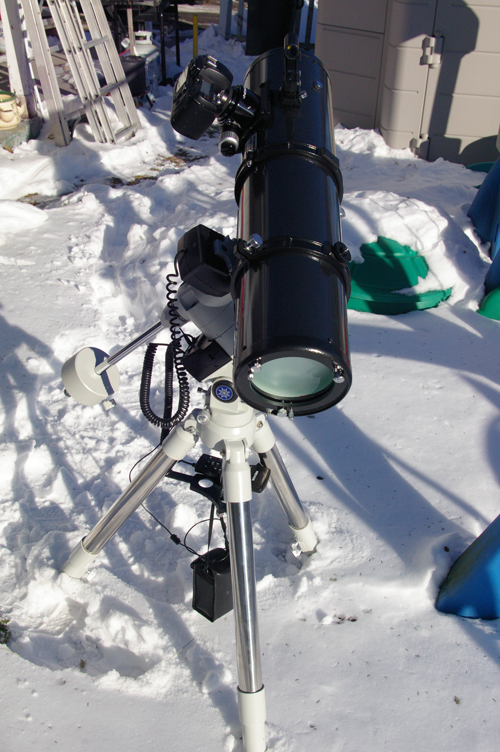
In 2014, I purchased a new mount for the 6-inch reflector. I now have obtained a Celextron VX mount and hope to put in an autoguiding camera. This will free me up from the guidescope and open new possibilities for me when I go to my dark sky site.
It has taken me over 30 years to get to this point. Am I satisfied? Heck no! Eventually, I want a large dark sky observatory (preferably ina warmer climate) with a 10-inch SCT and large (12 inches or larger) reflector. I can always dream about that next big scope.......